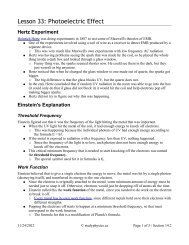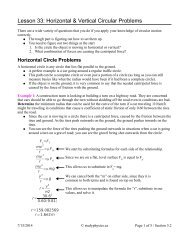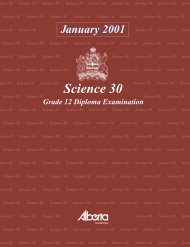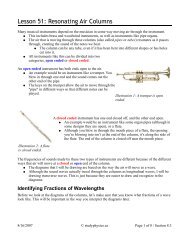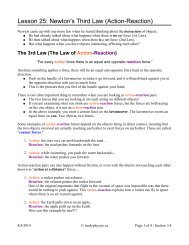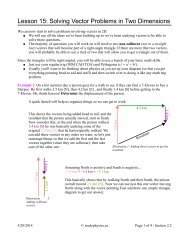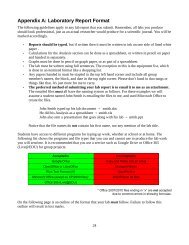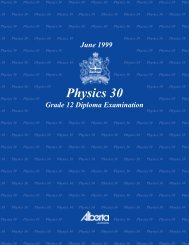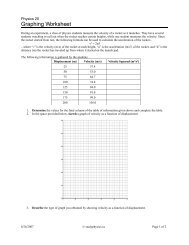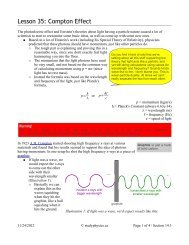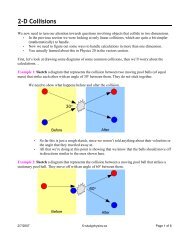Science 30 January 1999 Grade 12 Diploma Examination
Science 30 January 1999 Grade 12 Diploma Examination
Science 30 January 1999 Grade 12 Diploma Examination
Create successful ePaper yourself
Turn your PDF publications into a flip-book with our unique Google optimized e-Paper software.
cience <strong>30</strong> <strong>Science</strong> <strong>30</strong> <strong>Science</strong> <strong>30</strong> <strong>Science</strong> <strong>30</strong> <strong>Science</strong> <strong>30</strong> <strong>Science</strong> <strong>30</strong> <strong>Science</strong> <strong>30</strong> <strong>Science</strong> <strong>30</strong> Sciencience <strong>30</strong> <strong>Science</strong> <strong>30</strong> <strong>Science</strong> <strong>30</strong> <strong>Science</strong> <strong>30</strong> <strong>Science</strong> <strong>30</strong> <strong>Science</strong> <strong>30</strong> <strong>Science</strong> <strong>30</strong> <strong>Science</strong> <strong>30</strong> Scien<strong>30</strong> <strong>Science</strong> <strong>30</strong> <strong>Science</strong> <strong>30</strong> <strong>Science</strong> <strong>30</strong> <strong>Science</strong> <strong>30</strong> <strong>Science</strong> <strong>30</strong> <strong>Science</strong> <strong>30</strong> <strong>Science</strong> <strong>30</strong> <strong>Science</strong> <strong>30</strong>cience <strong>30</strong> <strong>Science</strong> <strong>30</strong> <strong>Science</strong> <strong>30</strong> <strong>Science</strong> <strong>30</strong> <strong>Science</strong> <strong>30</strong> <strong>Science</strong> <strong>30</strong> <strong>Science</strong> <strong>30</strong> <strong>Science</strong> <strong>30</strong> Scien<strong>30</strong> <strong>Science</strong> <strong>30</strong> <strong>Science</strong> <strong>30</strong> <strong>Science</strong> <strong>30</strong> <strong>Science</strong> <strong>30</strong> <strong>Science</strong> <strong>30</strong> <strong>Science</strong> <strong>30</strong> <strong>Science</strong> <strong>30</strong> <strong>Science</strong> <strong>30</strong><strong>January</strong> <strong>1999</strong>cience <strong>30</strong> <strong>Science</strong> <strong>30</strong> <strong>Science</strong> <strong>30</strong> <strong>Science</strong> <strong>30</strong> <strong>Science</strong> <strong>30</strong> <strong>Science</strong> <strong>30</strong> <strong>Science</strong> <strong>30</strong> <strong>Science</strong> <strong>30</strong> Scien<strong>30</strong> <strong>Science</strong> <strong>30</strong> <strong>Science</strong> <strong>30</strong> <strong>Science</strong> <strong>30</strong> <strong>Science</strong> <strong>30</strong> <strong>Science</strong> <strong>30</strong> <strong>Science</strong> <strong>30</strong> <strong>Science</strong> <strong>30</strong> <strong>Science</strong> <strong>30</strong>cience <strong>30</strong> <strong>Science</strong> <strong>30</strong> <strong>Science</strong> <strong>30</strong> <strong>Science</strong> <strong>30</strong> <strong>Science</strong> <strong>30</strong> <strong>Science</strong> <strong>30</strong> <strong>Science</strong> <strong>30</strong> <strong>Science</strong> <strong>30</strong> Scien<strong>30</strong> <strong>Science</strong> <strong>30</strong> <strong>Science</strong> <strong>30</strong> <strong>Science</strong> <strong>30</strong> <strong>Science</strong> <strong>30</strong> <strong>Science</strong> <strong>30</strong> <strong>Science</strong> <strong>30</strong> <strong>Science</strong> <strong>30</strong> <strong>Science</strong> <strong>30</strong><strong>Science</strong> <strong>30</strong>cience <strong>30</strong> <strong>Science</strong> <strong>30</strong> <strong>Science</strong> <strong>30</strong> <strong>Science</strong> <strong>30</strong> <strong>Science</strong> <strong>30</strong> <strong>Science</strong> <strong>30</strong> <strong>Science</strong> <strong>30</strong> <strong>Science</strong> <strong>30</strong> Scien<strong>Grade</strong> <strong>12</strong> <strong>Diploma</strong> <strong>Examination</strong><strong>30</strong> <strong>Science</strong> <strong>30</strong> <strong>Science</strong> <strong>30</strong> <strong>Science</strong> <strong>30</strong> <strong>Science</strong> <strong>30</strong> <strong>Science</strong> <strong>30</strong> <strong>Science</strong> <strong>30</strong> <strong>Science</strong> <strong>30</strong> <strong>Science</strong> <strong>30</strong>cience <strong>30</strong> <strong>Science</strong> <strong>30</strong> <strong>Science</strong> <strong>30</strong> <strong>Science</strong> <strong>30</strong> <strong>Science</strong> <strong>30</strong> <strong>Science</strong> <strong>30</strong> <strong>Science</strong> <strong>30</strong> <strong>Science</strong> <strong>30</strong> Scien<strong>30</strong> <strong>Science</strong> <strong>30</strong> <strong>Science</strong> <strong>30</strong> <strong>Science</strong> <strong>30</strong> <strong>Science</strong> <strong>30</strong> <strong>Science</strong> <strong>30</strong> <strong>Science</strong> <strong>30</strong> <strong>Science</strong> <strong>30</strong> <strong>Science</strong> <strong>30</strong>cience <strong>30</strong> <strong>Science</strong> <strong>30</strong> <strong>Science</strong> <strong>30</strong> <strong>Science</strong> <strong>30</strong> <strong>Science</strong> <strong>30</strong> <strong>Science</strong> <strong>30</strong> <strong>Science</strong> <strong>30</strong> <strong>Science</strong> <strong>30</strong> Scien<strong>30</strong> <strong>Science</strong> <strong>30</strong> <strong>Science</strong> <strong>30</strong> <strong>Science</strong> <strong>30</strong> <strong>Science</strong> <strong>30</strong> <strong>Science</strong> <strong>30</strong> <strong>Science</strong> <strong>30</strong> <strong>Science</strong> <strong>30</strong> <strong>Science</strong> <strong>30</strong>cience <strong>30</strong> <strong>Science</strong> <strong>30</strong> <strong>Science</strong> <strong>30</strong> <strong>Science</strong> <strong>30</strong> <strong>Science</strong> <strong>30</strong> <strong>Science</strong> <strong>30</strong> <strong>Science</strong> <strong>30</strong> <strong>Science</strong> <strong>30</strong> Scien<strong>30</strong> <strong>Science</strong> <strong>30</strong> <strong>Science</strong> <strong>30</strong> <strong>Science</strong> <strong>30</strong> <strong>Science</strong> <strong>30</strong> <strong>Science</strong> <strong>30</strong> <strong>Science</strong> <strong>30</strong> <strong>Science</strong> <strong>30</strong> <strong>Science</strong> <strong>30</strong>cience <strong>30</strong> <strong>Science</strong> <strong>30</strong> <strong>Science</strong> <strong>30</strong> <strong>Science</strong> <strong>30</strong> <strong>Science</strong> <strong>30</strong> <strong>Science</strong> <strong>30</strong> <strong>Science</strong> <strong>30</strong> <strong>Science</strong> <strong>30</strong> Scien<strong>30</strong> <strong>Science</strong> <strong>30</strong> <strong>Science</strong> <strong>30</strong> <strong>Science</strong> <strong>30</strong> <strong>Science</strong> <strong>30</strong> <strong>Science</strong> <strong>30</strong> <strong>Science</strong> <strong>30</strong> <strong>Science</strong> <strong>30</strong> <strong>Science</strong> <strong>30</strong>cience <strong>30</strong> <strong>Science</strong> <strong>30</strong> <strong>Science</strong> <strong>30</strong> <strong>Science</strong> <strong>30</strong> <strong>Science</strong> <strong>30</strong> <strong>Science</strong> <strong>30</strong> <strong>Science</strong> <strong>30</strong> <strong>Science</strong> <strong>30</strong> Scieni<strong>30</strong> <strong>Science</strong> <strong>30</strong> <strong>Science</strong> <strong>30</strong> <strong>Science</strong> <strong>30</strong> <strong>Science</strong> <strong>30</strong> <strong>Science</strong> <strong>30</strong> <strong>Science</strong> <strong>30</strong> <strong>Science</strong> <strong>30</strong> <strong>Science</strong> <strong>30</strong>
<strong>January</strong> <strong>1999</strong><strong>Science</strong> <strong>30</strong><strong>Grade</strong> <strong>12</strong> <strong>Diploma</strong> <strong>Examination</strong>DescriptionTime: 2.5 h. This examination wasdeveloped to be completed in 2.5 h;however, you may take an additional0.5 h to complete the examination.This is a closed-book examinationconsisting of• 40 multiple-choice and <strong>12</strong> numericalresponsequestions of equal value,worth 65% of the examination• 1 short-answer question and 2 longanswerquestions, worth 35% of theexamination.This examination contains setsof related questions.A set of questions may containmultiple-choice and/or numericalresponseand/or written-responsequestions.A science data booklet is provided foryour reference.Note: The perforated pages at the back ofthis booklet may be torn out and used foryour rough work. No marks will be givenfor work done on the tear-out pages.Instructions• You are expected to provide your ownscientific calculator.• Use only an HB pencil for themachine-scored answer sheet.• Fill in the information required on theanswer sheet and the examinationbooklet as directed by the presidingexaminer.• Read each question carefully.• Consider all numbers used in theexamination to be the result of ameasurement or observation.• When performing calculations, use thevalues of the constants provided in thedata booklet. Do not use the valuesprogrammed in your calculator.• If you wish to change an answer, eraseall traces of your first answer.• Do not fold the answer sheet.• The presiding examiner will collectyour answer sheet and examinationbooklet and send them to AlbertaEducation.• Now turn this page and read thedetailed instructions for answeringmachine-scored and written-responsequestions.
Multiple Choice• Decide which of the choices bestcompletes the statement or answersthe question.• Locate that question number on theseparate answer sheet provided andfill in the circle that corresponds toyour choice.ExampleThis examination is for the subject ofA. scienceB. biologyC. physicsD. chemistryAnswer SheetA B C DNumerical Response• Record your answer on the answersheet provided by writing it in theboxes and then filling in thecorresponding circles.• If an answer is a value between 0 and 1(e.g., 0.25), then be sure to record the 0before the decimal place.• Enter the first digit of your answerin the left-hand box and leave anyunused boxes blank.ExamplesCalculation Question and SolutionThe average of the values 21.0, 25.5, and24.5 is _________.(Record your answer to three digits in thenumerical-response section on the answersheet.)Average = (21.0 + 25.5 + 24.5)/3= 23.666= 23.7 (rounded to three digitsRecord 23.7 on theanswer sheet 2 3 . 7. .0 0 0 01 1 1 <strong>12</strong> 2 2 23 3 3 34 4 4 45 5 5 56 6 6 67 7 7 78 8 8 89 9 9 9ii
Written ResponseCorrect-Order Question and SolutionWhen the following subjects are arranged inalphabetical order, the order is ____, ____,____, and ____ .1 physics2 biology3 science4 chemistry(Record all four digits of your answer in thenumerical-response section on the answersheet.)Answer: 2413Record 2413 on theanswer sheet2 4 1 3. .0 0 0 01 1 1 <strong>12</strong> 2 2 23 3 3 34 4 4 45 5 5 56 6 6 67 7 7 78 8 8 89 9 9 9• Write your answers in the examinationbooklet as neatly as possible.• For full marks, your answers mustaddress all aspects of the question.• Descriptions and/or explanations ofconcepts must be correct and includepertinent ideas, diagrams, calculations,and formulas.• Your answers must be presented in awell-organized manner using completesentences, correct units, and significantdigits where appropriate.• Relevant scientific, technological, and/orsocietal concepts and examples must beidentified and made explicit.iii
The principles of biology, chemistry, and physics are applied at a medical facility.Use the following information to answer the next question.Structural Formula of a DisinfectantH H HH ––––C – C – C – H–––HO–HH1. The substance shown above is used as a disinfectant. Its chemical name isA. propaneB. 2-ethaneC. methanolD. 2-propanol2. A patient is treated for an electrical shock. When he received the shock, his skin hada resistance of 500 and he was grounded with a 115 V line. The current that flowedthrough his body wasA. 0.2<strong>30</strong> AB. 4.35 AC. 385 AD. 615 A3. The component in blood that is responsible for clotting isA. white blood cellsB. red blood cellsC. helper T cellsD. platelets1
4. Some forms of cancer can be treated by exposure of the affected tissues tocobalt-60, a radioactive isotope. In the equation for the production of this isotope,x represents59 60Co + x Co2727A. a protonB. a neutronC. an electronD. an alpha particleUse the following information to answer the next question.Measuring Blood PressureRubber cuff inflated with airVessel X5. The vessel labelled X, which is compressed by the cuff, carries blood away fromthe heart. The vessel isA. an artery carrying oxygenated bloodB. an artery carrying deoxygenated bloodC. a vein carrying oxygenated bloodD. a vein carrying deoxygenated blood2
6. The blood in the veins of the leg can flow against the force of gravity becauseA. veins have one-way valves that help return blood to the heartB. the blood in the veins is pulled by a vacuumC. veins carry deoxygenated bloodD. veins have thin walls7. Antibodies are important in the defence of the body. TheyA. are produced by antigens present in the bloodB. are produced in response to bacteria and viruses in the blood or tissuesC. combine with phagocytes to form cells that are resistant to invading particlesD. combine with antigens to form chemical compounds that protect the bodyagainst bacteria or viruses8. The sympathetic nervous system is likely most active when a person isA. running a raceB. digesting a large mealC. sleeping in the afternoonD. recovering from an illness3
Genetic research has a significant impact on the development of medical technology.Use the following information to answer the next three questions.A Potential Gene TherapyA protein known as VP22, which is made by the cold sore virus, seems tohave good potential for gene therapy. It moves freely into and out of cells andtheir nuclei. Experiments have been performed in which the gene thatproduces VP22 has been introduced into mammalian cells. When the geneenters a cell, VP22 is produced. The protein VP22 then enters an average of200 neighbouring cells. In this way, scientists can use the VP22 as a carrierfor distributing genetic material, proteins, or drugs.9. When the gene that produces VP22 enters the nucleus of a cell and begins theproduction of VP22, the cell is expressingA. a point mutationB. a recessive geneC. recombinant DNAD. a chromosomal abnormality10. In most cases, when foreign proteins such as VP22 enter the body, they are initiallyattacked byA. antibodiesB. macrophagesC. helper T cellsD. killer (cytotoxic) T cells4
Use the following additional information to answer the next question.Steps for Using VP22 on a Rabbit1 The drug affects the functioning of the liver.2 Drug molecules are attached to VP22 molecules in the lab.3 The drug molecules attached to the VP22 enter the cells of the rabbit,including the liver cells.4 The drug molecules attached to the VP22 are injected into the bloodstreamof the rabbit.Numerical Response01. Researchers wish to use a drug to treat the diseased liver of a rabbit using VP22.The order in which the steps must occur is _____, _____, _____, and _____.(Record your four-digit answer in the numerical-response section on the answer sheet.)5
Use the following information to answer the next two questions.Early in 1997, a group of researchers in Scotland reported that they had cloneda sheep using genetic material from an adult female sheep. They named theclone Dolly. The following diagram outlines how this cloning wasaccomplished.Process of Cloning a SheepSheep ARemoveudder cellfrom sheep AFuse cellsRemove DNA fromunfertilized eggZygote withDNA fromsheep ACultureImplantedsurrogateClone of A (Dolly)11. The percentage of genetic material that the clone (Dolly) has in common withsheep A is approximatelyA. 0%B. 25%C. 50%D. 100%6
<strong>12</strong>. The zygote is cultured and is implanted as a multicelled embryo. During the steplabelled “Culture,” the cells of the future clone undergoA. mitosisB. meiosisC. fertilizationD. gene splicingUse the following information to answer the next question.Punnett Squares1TTT2TTttt3tTt4tttttT – Dominant traitt – Recessive traitNumerical Response02. Inherited traits are determined by the gene pairs of parents. Match the Punnettsquare, as numbered above, with the probability of a recessive trait being expressedin the offspring, as listed below.0% _____ (Record in the first column.)25% _____ (Record in the second column.)50% _____ (Record in the third column.)100% _____ (Record in the fourth column.)(Record your answer in the numerical-response section on the answer sheet.)7
The petroleum industry has a significant environmental and economic impact in Alberta.13. When technologists explore for oil deposits, they pass sound waves throughsedimentary rock to determine the thickness of the layers. As the sound wavestravel from one sedimentary layer to another, their paths are bent. This phenomenais similar to theA. reflection of light by a mirrorB. polarization of light by sunglassesC. amplification of light by a laser sourceD. refraction of light entering water from airUse the following information to answer the next question.Pipeline welders use ethyne (acetylene) as a fuel for “cutting torches.” Thebalanced equation for the combustion of acetylene is2 C 2 H 2(g) + 5 O 2(g) 4 CO 2(g) + 2 H 2 O (g)14. The energy conversion that occurs during this reaction is fromA. chemical to thermal energyB. electrical to thermal energyC. thermal to mechanical energyD. electromagnetic radiation to chemical energy8
15. Sparks from static electricity pose a hazard in petroleum plants. As two chargedobjects separate, the field strength between themA. decreases in proportion to the square of the distance that separates themB. increases in proportion to the square of the distance that separates themC. decreases in proportion to the distance that separates themD. increases in proportion to the distance that separates them16. Electrical fields resemble magnetic and gravitational fields in that they allA. have the same constantB. cause a compass needle to swingC. exert an attractive and repulsive forceD. are affected by the distance between two sources17. Many oil well pumpjacks operate using electric motors. The electricity must betransmitted over long distances because oil wells are often located in remotelocations. Efficient transmission requiresA. high voltage, low current, and AC linesB. low voltage, high current, and AC linesC. low voltage, high current, and DC linesD. high voltage, high current, and DC lines18. In order for the electric motor of an oil well pumpjack to function, voltage andamperage must be changed. This is accomplished through the use ofA. a resistorB. a generatorC. a transformerD. an AC/DC converter9
Use the following information to answer the next question.Four Fractions of a Crude Oil SampleFraction Flame Colour1 red–yellow2 bright yellow3 red4 blue–whiteNumerical Response04. A crude oil sample was distilled into four fractions. In an attempt to find the energyproduction of the fractions, a technician burned equal quantities of each. Thetechnician observed that the fractions burned at different temperatures.List the fractions in order from the one with the coolest burning temperature to the onewith the hottest burning temperature.Answer: _____ _____ _____ _____coolest hottest(Record your four-digit answer in the numerical-response section on the answer sheet.)20. Various fractions of natural gas, such as ethene (C 2 H 4(g) ), are produced in thepetrochemical industry. To produce the solvent used in dry cleaning, chlorine andfluorine are substituted for the hydrogens, which produces dichlorodifluoroethene.This compound poses the greatest environmental danger asA. a greenhouse gasB. an ozone-depleting compoundC. an oxygen block in red blood cellsD. a component of photochemical smog11
Use the following information to answer the next question.Production of EtheneC 2 H 6(g)1100 C C 2 H 4(g) + H 2(g)21. Once ethene is formed from ethane, it can be used for polymerization intopolyethylene. To increase the energy efficiency of ethene production, a chemicalplant couldA. use hydrogen as a fuel to heat the ethaneB. reduce the temperature of the reacting chamberC. reduce the amount of hydrogen produced by the reactionD. sell the hydrogen to a fertilizer plant in exchange for ethane<strong>12</strong>
An important aspect of science literacy is the ability to analyze environmental issues.Use the following information to answer the next question.H 2 S (g) + Pb(CH 3 COO) 2(s)Detection of H 2 S (g)UV PbS (s) + 2 CH 3 COOH (g)(colourless) (colourless) (black) (colourless)22. Hydrogen sulphide (H 2 S (g) ) is a dangerous gas found in “sour” natural gas.H 2 S (g) can be detected using UV light, which will cause H 2 S (g) to react withlead (II) acetate to produce a black compound. This detection can occur becauseUV light has a uniqueA. speedB. sourceC. wavelengthD. temperatureUse the following information to answer the next question.Reaction of H 2 S (g) with WaterH 2 S (g) + H 2 O (l)H 3 O + (aq) + HS– (aq)23. Hydrogen sulphide (H 2 S (g) ) reacts with water in the air to form acid rain. TheBrønsted–Lowry bases in this equation areA. H 2 O (l) and H 2 S (g)B. H 2 O (l) and HS – (aq)C. H 2 S (g) and HS – (aq)D. H 2 S (g) and H 3 O + (aq)13
24. The use of pesticides may pose a problem because pesticides sometimesA. do not biodegrade easilyB. decrease the global rate of photosynthesisC. increase the biochemical oxygen demand of waterD. increase the amount of ultraviolet light entering the atmosphere25. The pollutants that contribute most to acid deposition areA. CO (g) and NO 2(g)B. SO 2(g) and NO 2(g)C. CO (g) and SO 2(g)D. NO 2(g) and O 3(g)Numerical Response05. The pH of a sample of lake water is 3.42. The hydronium ion concentration [H 3 O + (aq) ]of the sample is __________. 10 –4 mol/L.(Record your answer to two digits in the numerical-response section on the answer sheet.)26. When a few drops of indicator bromothymol blue are added to a lake water samplewith a pH of 3.42, the colour of the sample isA. redB. greenC. orangeD. yellow27. Acid deposition may change the pH of a lake. In addition, as acidified water passesthrough soil and into the lake, it may alsoA. increase the temperature of the lakeB. reduce the dissolved oxygen content of the lakeC. increase the decay rate of organic matter in the lakeD. increase the concentration of dissolved metal ions in the lake14
Short Answer – 5%In a lab, you are asked to determine the concentration of a strong acid by titrating it with astrong base. Outline the steps you would take to carry out the titration using the followingequipment and supplies. Include set-up and clean-up procedures.buretfunnelpipette and bulb (or pump)distilled waterErlenmeyer flasksmicropipettegraduated cylinderdrop plateindicator (bromothymol blue) strong base (NaOH (aq) )strong acid (HCl (aq) )Note: You may choose to not use all of the equipment to carry out the procedure.15
Use the following information to answer the next question.Pollutants1 SO 2(g)2 Raw sewage3 Heavy metals4 CFCsNumerical Response06. Match each pollutant, as numbered above, with its effect, as listed below. Useeach number only once.Nervous system damage _____ (Record in the first column.)High biological oxygen demand (BOD) _____ (Record in the second column)Ozone depletion _____ (Record in the third column.)Acid deposition _____ (Record in the fourth column.)(Record your answer in the numerical-response section on the answer sheet.)16
Use the following information to answer the next question.Sources of Pollutants and Their EffectsSources Compounds EffectsEnergyproductionSulphurdioxideAcidificationAgricultureAmmoniaEutrophicationof lakesIndustryNitrogenoxidesTrafficVOCRegionalozoneCarbonmonoxideFreetroposphericozoneMethane28. Taking into account the sources of nitrogen oxide shown in the chart above, onecan infer that the release of nitrogen oxide is mainly fromA. the production of ammoniaB. the combustion of fossil fuelsC. algal bloom in lakes and oceansD. extensive use of fertilizers in agriculture and gardening17
Use the following information to answer the next two questions.It has been hypothesized that some frog species in Oregon are in danger ofbecoming extinct because of increased exposure to ultraviolet radiation.29. An increase in exposure has occurred because ofA. the greenhouse effectB. increases in carbon dioxide concentrationC. the thinning of the ozone layer in the atmosphereD. increases in dioxins and furans in the environmentUse the following additional information to answer the next question.It was hypothesized that ultraviolet radiation damages the eggs of sensitivespecies. In an experiment to test this hypothesis, eggs from a sensitive speciesof frog were divided into two groups. One group was shielded fromultraviolet rays with special filtering. The other group was not shielded. Thenumber of eggs that survived in each group was recorded.Parts of the Study1 Uncovered frog eggs2 Percentage of eggs surviving3 Covered frog eggs4 Species of frogNumerical Response07. Match the parts of the study, as numbered above, with the following terms. Use eachnumber only once.Manipulated variable _____ (Record in the first column.)Responding variable _____ (Record in the second column.)Controlled variable _____ (Record in the third column.)Control group _____ (Record in the fourth column.)(Record your answer in the numerical-response section on the answer sheet.)18
Environmental impacts must be considered in energy production and use.<strong>30</strong>. The most powerful argument against the development of fission nuclear power isrelated toA. the cost of fuelB. thermal pollutionC. availability of fuelD. disposal of radioactive wastesNumerical Response08. Electrical power in North America is generated at a frequency of 60.0 Hz.The wavelength of electromagnetic radiation emitted from a power line wouldbe __________ 10 6 m.(Record your answer to three digits in the numerical-response section on the answer sheet.)19
31. Which of the following graphs represents the relationship between the distancefrom transmission lines and the degree of exposure to electromagnetic radiation?A.B.Degree of exposureDegree of exposureDistance from sourceDistance from sourceC.D.Degree of exposureDegree of exposureDistance from sourceDistance from source20
Use the following information to answer the next question.Diagrams of Processes Used in the Production of Electricity<strong>12</strong>3Boiling waterSteam4C +CNumerical Response09. Match each diagram, as numbered above, with the name of its corresponding process.Chemical reaction _____ (Record in the first column.)Nuclear fission _____ (Record in the second column.)Nuclear fusion _____ (Record in the third column.)Physical change _____ (Record in the fourth column.)(Record your answer in the numerical-response section on the answer sheet.)21
Use the following information to answer the next question.Combustion of EthanolC 2 H 5 OH (l) + 3 O 2(g) 2 CO 2(g) + 3 H 2 O (g)32. Blended gasoline (E-85 ethanol) is a fuel containing 85% ethanol and 15%unleaded gasoline. The heat of combustion of ethanol isA. 857.4 kJ/molB. –151.7 kJ/molC. –<strong>12</strong>35.3 kJ/molD. –2299.4 kJ/molUse the following information to answer the next question.A Reaction at a RefineryH –H O H–=–C – C – C – OH + 3 H 2(g)––HHH –H H H–––C – C – C – H + 2 H 2O (g)–––HHHCompound X33. The functional groups present in Compound X make it possible to classifyCompound X as bothA. an ester and an alcoholB. a ketone and an alcoholC. an ester and a carboxylic acidD. a ketone and a carboxylic acid22
Use the following information to answer the next question.Amount of Fuel Consumed by Mode of TransportationMode ofTransportationNumber ofPeopleTravellingLitres of FuelUsed per100 kmLitres of Fuel Usedper 100 kmper Person1 car2 car3 van4 bus5 train6 jet<strong>12</strong>6501 000100101020852 8001 <strong>12</strong>0105.03.31.72.811.2Numerical Response10. Of the modes of transportation numbered above, the four most energy-efficient modesare _____, _____, _____, and _____.(Record your four-digit answer in any order in the numerical-response section on the answer sheet.)23
Use the following information to answer the next question.Automobile Gasoline Consumption1975 1995Average gasoline consumption of automobiles 15.3 L/100 km 7.9 L/100 kmNumber of automobiles registered in Canada 8 541 000 17 816 000Gasoline consumption by automobiles <strong>12</strong> GL/a* <strong>30</strong> GL/a**GL/a - gigalitres per year34. The information in the table indicates that the increased gasoline consumption from1975 to 1995 can be attributed toA. a decrease in engine efficiencyB. a decrease in the energy in the gasolineC. an increase in the size of the automobile enginesD. an increase in the overall number of kilometres driven24
Use the following information to answer the next question.Comparison of Energy Consumption by SourceCanada’s Energy Mix – 1990Oil<strong>30</strong>.9%Natural gas23.2%Hydroelectricity25.2%Coal13.4%Nuclearenergy7.3%Total Canadianconsumption = 248.0 million tonnesoil equivalentWorld Energy Mix – 1990Oil38.8%Natural gas21.3%Hydroelectricity6.6%Nuclear energy5.6%Coal27.7%Total Worldconsumption = 8004.0 million tonnesoil equivalent35. According to the graphs above, Canada consumed—from BP World Statistical Review of World Energy, 1991A. 25% of the total world energyB. fossil fuels for less than 50% of its energyC. a lower percentage of nuclear energy than did the total worldD. a greater percentage of renewable energy than did the total world25
A series of experiments were conducted in a research lab on a space station.Use the following information to answer the next question.Characteristics of Some Electromagnetic RadiationIIIIIIIVTravels at 3.0 10 8 m/sIs visibleCan be reflectedHas a longer wavelength than ultraviolet rays36. X-rays and light rays are similar in that both have characteristicsA. I and IIIB. I and IVC. II and IVD. III and IV37. Radiation from a comet is detected at a wavelength of 6.6 10 –8 m, whichindicates the presence of iron. What part of the electromagnetic spectrum wouldcontain this wavelength?A. InfraredB. UltravioletC. Visible redD. Visible violet26
Use the following information to answer the next question.Radio Wave Pattern38. The radio wave above has beenA. internally reflectedB. externally reflectedC. frequency modulatedD. amplitude modulatedUse the following information to answer the next question.Electromagnetic Radiation (EMR) Terms1 Total internal reflection2 Doppler effect3 Emission spectrum4 Radio wavesNumerical Response11. Match the EMR terms, as numbered above, with their uses, as listed below. Use eachnumber only once.Motion of stars _____ (Record in the first column.)Fibre optic cables _____ (Record in the second column.)Composition of stars _____ (Record in the third column.)Cellular phones _____ (Record in the fourth column.)(Record your answer in the numerical-response section on the answer sheet.)27
Use the following information to answer the next question.Induction of a CurrentMagnetDirectionINSDirectionII39. Which of the following statements describes induction as depicted by the apparatusshown above?A. When the magnet is held stationary, only direct current flows in the wire.B. When the magnet is held stationary, only alternating current flows in the wire.C. When the magnet moves in direction I, electrons flow in the wire in the samedirection as they do when the magnet moves in direction II.D. When the magnet moves in direction I, electrons flow in the wire in theopposite direction as they do when the magnet moves in direction II.Numerical Response<strong>12</strong>. To conduct an experiment aboard a space station, 24.0 V from a solar panel istransformed to 480 V. If the transformer’s secondary coil has 10 000 turns of wire,the primary coil has __________ turns.(Record your answer to three digits in the numerical-response section on the answer sheet.)28
40. A technician on a space station wished to build a circuit using three identicalresistors such that the circuit would have the least total resistance. Which of thefollowing circuits would have the ammeter with the highest reading?A. B.AAC. D.AA29
Long Answer – 15%1. Many scientists have suggested that there is a link between levels of blood pressureand regular exercise. A group of <strong>Science</strong> <strong>30</strong> students developed the prediction thatstudents who exercise regularly would experience a smaller increase in bloodpressure after exercise compared with students who do not exercise regularly. Thefollowing experiment was designed to test their hypothesis.Group 1 consisted of six male students aged 16 to 19 who were members of theschool’s basketball team. Group 2 consisted of six students who did not exerciseregularly. The systolic blood pressures of all of these students were measured andrecorded when the students were at rest. Their systolic blood pressures weremeasured again immediately after the students ran 5 laps of the gymnasium. Thefollowing is a graph of the data obtained.Effect of Exercise on Blood PressureAverage systolic blood pressure (mm Hg)200150100500Before exercise After exerciseActivity levelGroup 1Group 2a. Describe two ways in which the body controls blood pressure.......................................................................................................................................................................................................................................................................................................................................................................................................................................................................................................................................................................................................................................................<strong>30</strong>
. Identify the manipulated and the responding variables in this study...........................................................................................................................................................................................................................................................................................................................................................................................................................................................................................................................................................................................................................................................................................................................................................................................................................................c. Interpret the data as represented by the graph. You can do this by summarizing theobservations and giving possible reasons for the results of the experiment. Evaluatethe study by criticizing the design and outlining the methods you would use toimprove it.................................................................................................................................................................................................................................................................................................................................................................................................................................................................................................................................................................................................................................................................................................................................................................................................................................................................................................................................................................................................................................................................................................................................................................................................................................................................................................................................................................................................................................................................................................................................................................................................................................................................................................................................................................................................................................................................................................................................................................................................................................................................................................................................................................................................................................................continued31
..................................................................................................................................................................................................................................................................................................................................................................................................................................................................................................................................................................................................................................................................................................................................................................................................................................................................................................................................................................................................................................................................................................................................................................................................................................................................................................................................................................................................................................................................................................................................................................................................................................................................................................................................................................................................................................................................................................................................................................................................................................................................................................................................................................................................................................................................................................................................................................................................................................................................................................................................................................................................................................................................................................................................................................................................................................................................................................................................................................................................................................................................................................................................................................................................................................................................................................................................................................................................................................................................................................................................................................................................................................................................................................................................................................................................................................................................................................................................................................................................................................................................................................................................................................................................................32
Long Answer – 15%2. The world demand for electrical energy continues to increase. Describe theenvironmental problems that accompany the production of electrical energy.What steps should be taken over the next decade to deal with this issue?......................................................................................................................................................................................................................................................................................................................................................................................................................................................................................................................................................................................................................................................................................................................................................................................................................................................................................................................................................................................................................................................................................................................................................................................................................................................................................................................................................................................................................................................................................................................................................................................................................................................................................................................................................................................................................................................................................................................................................................................................................................................................................................................................................................................................................................................................................................................................................................................................................................................................................................................................................................................................................................................................................................................................................................................................................................................................................................................................................................................................................................................................................................................................................................................................................................................................................................................................................................................................................................................................................................................................................................................................................................................................................................................................................................................................................................................................33
....................................................................................................................................................................................................................................................................................................................................................................................................................................................................................................................................................................................................................................................................................................................................................................................................................................................................................................................................................................................................................................................................................................................................................................................................................................................................................................................................................................................................................................................................................................................................................................................................................................................................................................................................................................................................................................................................................................................................................................................................................................................................................................................................................................................................................................................................................................................................................................................................................................................................................................................................................................................................................................................................................................................................................................................................................................................................................................................................................................................................................................................................................................................................................................................................................................................................................................................................................................................................................................................................................................................................................................................................................................................................................................................................................................................................................................................................................................................................................................................................................................................................................................................................................................You have now completed the examination.If you have time, you may wish to check your answers.34
CreditMC35Graphs from British Petroleum World Statistical Review of World Energy,June 1991. Reprinted by permission of the British Petroleum Company p.l.c.35
<strong>Science</strong> <strong>30</strong><strong>Diploma</strong> <strong>Examination</strong><strong>January</strong> <strong>1999</strong>KeysSample AnswersandScoring Guides
Jan <strong>1999</strong> (991)<strong>Science</strong> <strong>30</strong> <strong>Diploma</strong> <strong>Examination</strong> KeyMultiple-Choice1 D 21 A2 A 22 C3 D 23 B4 B 24 A5 A 25 B6 A 26 D7 B 27 D8 A 28 B9 C 29 C10 B <strong>30</strong> D11 D 31 B<strong>12</strong> A 32 C13 D 33 B14 A 34 D15 A 35 D16 D 36 A17 A 37 B18 C 38 D19 B 39 D20 B 40 BNumerical-ResponseNR 1 2431NR 2 <strong>12</strong>34NR 3 4231NR 4 3<strong>12</strong>4NR 5 3.8 or 3.80NR 6 3241NR 7 3241 or <strong>12</strong>43NR 8 5 or 5.0 or 5.00NR 9 4<strong>12</strong>3NR 10 2345 any orderNR 11 2134NR<strong>12</strong> 500
Scoring Guide – Short Answer <strong>January</strong> <strong>1999</strong> <strong>Diploma</strong> <strong>Examination</strong>Score4StandardofExcellence32AcceptableStandardScoring DescriptionsThe response reflects an accurate understanding of the titration procedure. Thesteps and equipment used are appropriate.The response reflects an adequate understanding of the titration procedure. Thesteps and equipment apply to the titration procedure.The response reflects a sketchy understanding of the titration procedure. The stepsand equipment generally apply to titration procedure.The response reflects a poor understanding of the titration procedure. The stepsand equipment do not apply to titration procedure.10 The response does not address any of the major points of the question at anappropriate level for a <strong>30</strong>-level course.Sample Answer – Short AnswerRinse a buret with water, then with the strong base. Put some base in the buret and recordthe initial volume.Add an indicator (bromothymol blue) to 10 mL of acid.Carefully add the base to the acid until the indicator changes colour.Record the final volume on the buret and subtract the initial volume.Rinse the buret and other containers with water.
Scoring Guide – Long Answer 1 <strong>January</strong> <strong>1999</strong><strong>Diploma</strong> <strong>Examination</strong>SCORE4Standard ofExcellence32AcceptableStandard10NRSCORING DESCRIPTIONSThe response is complete, well organized, and reflects thorough understanding andlogical consistency of thought. The list of mechanisms for the control of bloodpressure and identification of variables is correct. Interpretations of the graphs areinsightful. Measures to improve the experimental design are imaginative andrealistic.The response is mostly complete, organized, and reflects correct understanding.The list of mechanisms for the control of blood pressure and identification of variablesis correct. Interpretations of the graphs are mostly correct. Measures to improve theexperimental design are complete and realistic.The response is organized, and is generally logical and consistent . The list ofmechanisms for the control of blood pressure and identification of variables is mostlycorrect. Interpretations of the graphs are generally correct. Measures to improve theexperimental design are realistic.The response is incomplete, disorganized, and reflects poor understanding. Thelist of mechanisms for the control of blood pressure and identification of variables isincomplete. Interpretations of the graphs are poorly described. Measures to improvethe experimental design are unrealistic.The response does not address any of the major points of the question at an appropriatelevel for a <strong>30</strong>-level course.No response.Sample Answer – Long Answer 1A. Blood pressure is controlled by the amount of blood returning to the right atrium ofthe heart and by the stretch receptors in the aorta. Lots of blood coming into the heartcauses the heart squeeze harder, raising the BP. If the stretch receptors in the aortaare stretched a lot, signals are sent to decrease the strength of the heart contractions.B. The manipulated variable is the amount of exercise the people do. The respondingvariable is the blood pressure after exercise.C. The graph supports the idea that people who exercise regularly will have less of a BPincrease after exercising than for people who don’t exercise regularly. Theexperiment has too small of a sample size. Other factors such as gender, size, weightetc. could be factors that affect blood pressure. Different amounts of exercise anddifferent ages of people could also have been tested.
Scoring Guide – Long Answer 2 <strong>January</strong> <strong>1999</strong> <strong>Diploma</strong> <strong>Examination</strong>SCORE4Standard ofExcellence32AcceptableStandard10SCORING DESCRIPTIONSThe response is complete, well organized, and reflects thorough understanding andlogical consistency of thought. The description of the environmental problemsassociated with energy production are complete and correct. Opinions about the stepsthat should be taken in the future are imaginative and realistic. Appropriateexamples and logical arguments are used to support opinions.The response is mostly complete, organized, and reflects correct understanding.The description of the environmental problems associated with energy production arecorrect. Opinions about the steps that should be taken in the future are complete andrealistic. Examples and logical arguments are used to support opinions.The response is organized, and is generally logical and consistent . The descriptionof the environmental problems associated with energy production are generallycorrect. Opinions about the steps that should be taken in the future are logical. Someexamples and arguments are used to support opinions.The response is incomplete, disorganized, and reflects poor understanding. Thedescription of the environmental problems associated with energy production are poor.Opinions about the steps that should be taken in the future are not logical. Examplesand arguments are not used to support opinions.The response does not address the question at a <strong>Science</strong> <strong>30</strong> level.
Sample Answer – Long Answer 2The main methods of electrical energy production are coal-fired, nuclear, and hydrogenerating power stations. The main environmental problems associated with the use offossil fuels such as coal are global warming and acid deposition. The carbon dioxideproduced by combustion causes a greenhouse effect in the atmosphere. Some scientiststhink that this will lead to disastrous changes in global climate and may cause widespreaddeath to many species including humans. Acid deposition is caused when sulphur oxidesand nitrogen oxides react with moisture in the air. This is causing the destruction ofmany terrestrial and aquatic habitats around the world. Leaching of heavy metals intowater habitats and thermal pollution are also problems associated with fossil fuelpoweredstations.Nuclear power production produces long-lasting radioactive wastes. Safe disposal ofthese wastes over thousands of years is not possible presently. Background radiation maycontinue to rise to catastrophic levels if accidents at power plants occur or if radioactivewastes leak into the environment. Not only will the organisms on which we rely forsurvival be affected, but many human deaths due to cancer will occur.While hydro power produces few contaminants it produces significant environmentaleffects. Damming a river causes flooding of the upstream part of the river. This changesthe habitats and displaces many kinds of plants and animals. It may also cause moreheavy metals to leach into the water. Silting may cause changes in the drainage patternsthroughout the area around the dam.Alternate forms of electrical energy such as photovoltaic cells, wind generators, tidalpower, and geothermal power stations have fewer environmental effects. Thedisadvantages of these power sources is the cost of building and maintaining theequipment necessary to run them, and in some cases, they are available in a limitednumber of places.The main strategy for the immediate future should be to reduce the consumption ofenergy. This can be done by educating people about the effects of energy production onthe environment. It might be necessary to lower our expectations for some of the luxuriesthat we now enjoy. People should be taught methods of conserving energy. Increasingthe cost of using energy might also be implemented by taxing excessive energy use.Besides reducing energy use, it is also necessary to develop cleaner ways of producingenergy. Development of technologies such as solar energy, wind, tidal, and geothermalpower stations should have a high priority. Nuclear fission may also provide a relativelyclean form of energy in the future.



